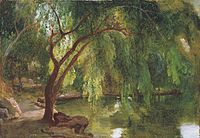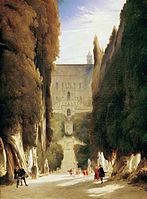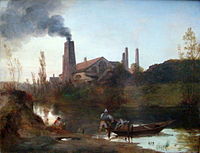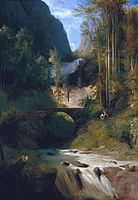Carl Blechen
Carl Eduard Ferdinand Blechen (born July 29, 1798 in Cottbus , † July 23, 1840 in Berlin ) was a German landscape painter and professor of landscape painting at the Berlin Academy of the Arts .
Life
Family and early years
Carl Blechen was born in 1798 on Luckische Gasse (today Berliner Straße) in Cottbus. He came from a modest background, his father Adrian Blechen was a tax officer from Regensburg and his mother Johanna Christiana, née Happatz, the daughter of a Wendish tailor. From 1805 to 1815 Carl Blechen attended the Cottbus Lyceum at the Oberkirche, where he particularly benefited from the influence of the painter Christian Gottlieb Lemmrich , who was Blechen's teacher at the time. Since his parents could not afford the money to study, he began an apprenticeship as a banker , which he completed in 1819. Immediately thereafter, he volunteered for the Guard Pioneer Battalion for a year. After this time he started working in a bank. In his free time he was increasingly occupied with painting. In 1822 he began studying at the Berlin Academy of the Arts , a year later he went on a study trip to Dresden and Saxon Switzerland .
freelance artist
After his return, Carl Blechen got a job as a decorative painter at the Königsstädtisches Theater on Alexanderplatz in Berlin. His marriage to the cleaner Henriette Boldt took place on December 27, 1824. Two years later, Blechen was accepted into the Berlin Artists' Association. In 1827 he was dismissed from the theater because of a quarrel with the singer Henriette Sontag . From that time on, Blechen worked as a freelance painter. A study trip to the Baltic Sea followed in the summer of 1828. Following this, from September 1828 to November 1829, he embarked on an extensive and restless trip to Italy, where he met Carl Wilhelm Götzloff , among others , and in the course of which he made hundreds of sketches that were later worked out in the Berlin studio. Deeply impressed by the sun-drenched landscape, Blechen came up with a new way of seeing and painting, the value of which, however, would never reveal itself to many of his contemporaries, as it did not correspond to the "romanticizing" style customary at the time, but was more oriented towards reality (e.g. B. his pictures of the paper mills near Amalfi ).
Professor of landscape painting at the Berlin Academy
In 1831 Carl Blechen was appointed professor of landscape painting at the Berlin Academy on the recommendation of Karl Friedrich Schinkel . In 1835 he was made a full member.
The painter's next trip took him to the Harz Mountains in 1833 , and the first signs of mental illness appeared two years later. In the same year, Blechen was elected a full member of the Akademie der Künste and made another trip, this time to Paris.
Since the health of the now well-known landscape painter deteriorated and he suffered from severe depression , he was given leave of absence from teaching in 1836. In the following year, Blechen had to be admitted to a clinic, after which he went on a recreational trip to Dresden. His last drawing was made at this time.
On July 23, 1840, Carl Blechen died of mental derangement. He found his final resting place in the Dreifaltigkeitskirchhof II in Berlin-Kreuzberg. The exact location of the grave can no longer be determined. A memorial plaque on the cemetery wall in field B1 reminds of sheet metal. His grave was dedicated as an honor grave in Berlin until 2014 .
plant
“He was a gifted painter by God's grace. One of the few chosen ones who was not only one of the best of his time ... but also had a decisive influence on the best of his time, such as Menzel . "
Art-historical classification
Blechen's landscape paintings show a new realism , old positions of early romanticism are abandoned. Blechen ironizes the expectations of an audience that is used to idealistic and heroic exaggerations of landscapes, as shown in pictures by Jakob Philipp Hackert or Joseph Anton Koch , or appreciates the idyll of Salomon Gessner . Blechen drives out the emotions of romanticism and the staidness of Biedermeier from landscape painting . In an authentic way, he creates natural moods with grandiose light and color effects. The motifs are there to show the incidence of light and the color effect of the sun's rays. After his trip to Italy, the effect of bright sunlight becomes the dominant motif of his landscapes - he aims in the same direction as the outdoor painting of the Impressionists.
Exhibitions
The birthday of the most important landscape painter of the early 19th century alongside Caspar David Friedrich was celebrated in 1998 for the 200th time. On the occasion of this anniversary, in and around Cottbus, in addition to the permanent presentation of his pictures in Branitz Castle , various events, exhibitions and concerts in honor of Carl Blechen took place.
The Berlin exhibition in 1990 on the occasion of the 150th anniversary of his death was an unusual event. At that time, the Berlin State Museums were still divided; originally, separate exhibitions were planned in East and West. The events of 1989 and 1990 in Germany led to these exhibitions being brought together. Blechen thus posthumously became an artistic companion of the reunification . The exhibition took place in the Neue Nationalgalerie .
From January 29 to April 11, 2010 the Alte Nationalgalerie Berlin showed a number of his oil paintings (also from other museums) under the title "Drawn with Light" from the art collection of the Academy of Arts , Berlin, the 66 light-flooded sheets in sepia and Graphite from Blechen's Amalfi sketchbook from 1829. From April 28 to July 18, 2010, the exhibition was on view in the Casa di Goethe in Rome: For the first time, this initial work of artistic modernism was presented in its entirety in the country. where it originated.
Works
- At the edge of the forest (Wuppertal, Von der Heydt-Museum , Inv.No. 0264), oil on wood, 34.5 × 53.5 cm
- The Waldschlucht (Berlin, Alte Nationalgalerie ), 1825, oil on canvas, 98 × 127 cm
- Gothic church ruins (Dresden, Gemäldegalerie , inv. No. 2637 A), 1826, oil on canvas, 129.5 × 96.5 cm
- Demonic landscape (Schweinfurt, Georg Schäfer Museum ), around 1826,
- Gothic church ruins (Dresden, Pillnitz Castle ), 1826
- Forest gorge with red deer (Hanover) Lower Saxony State Museum , 1828
- Bathers in the Park of Terni (Stuttgart, Staatsgalerie ), 1828/29, oil on paper, 36 × 26 cm
- Bathers in the Park of Terni (Düsseldorf, Kunstmuseum ), 1829, oil on canvas, 32 × 24.5 cm
- Grotto with two monks on the Gulf of Naples (Cologne, Wallraf-Richartz-Museum ), 1829
- The Roman Forum (Vienna, Belvedere ), 1829, oil on cardboard.
- Afternoon on Capri (Vienna, Belvedere), around 1829, oil on canvas.
- Vesuvius (Frankfurt am Main, Goethemuseum ), 1829, oil on cardboard.
- Grotto in the park of the Villa d'Este (Cottbus, Blechen memorial), around 1829–30, oil on canvas, 31 × 40 cm
- Country road in winter by moonlight (Lübeck, Museum Behnhaus Drägerhaus ), after 1829, oil on panel, 38.6 × 52.7 cm
- In the park of the Villa d'Este (Berlin, Alte Nationalgalerie), 1830, oil on canvas, 126 × 93 cm
- Santa Scholastica Monastery near Subiaco (Wuppertal, Von der Heydt-Museum, Inv.No. 0667), around 1830, oil on canvas, 110 × 77 cm
- In the park of the Villa Borghese (Berlin, Alte Nationalgalerie), around 1830, oil on canvas, 78 × 63 cm
- Rolling mill Neustadt-Eberswalde (Berlin, Alte Nationalgalerie), 1830, oil on panel, 26 × 33 cm
- The blown up tower of Heidelberg Castle (Bremen, Kunsthalle ), around 1830, oil on canvas, 80.5 × 92 cm
- Southern rock gorge with caves (Schweinfurt, Georg Schäfer Museum ), after 1830
- Building the Devil's Bridge (Munich, Neue Pinakothek , Inv. No. L 1039), around 1830–32, oil on canvas, 77.8 × 104.5 cm
- Two ladies in the park (Munich, Neue Pinakothek, inv. No. 9875), around 1830–32, oil on canvas, 39.5 × 33.2 cm
- Amalfi Mill Valley (Leipzig, Museum of Fine Arts ), 1831
- The Interior of the Palm House (Hamburg, Kunsthalle ), 1832–34, oil on canvas, 64 × 56 cm
- Pilgrims resting in a Gothic church ruin ( Kupferstichkabinett Berlin ), 1833–34, watercolor on vellum paper, 37.2 × 25.8 cm
- The Villa d'Este in Tivoli (Berlin, Nationalgalerie), 1831/32, oil on canvas, 127.5 × 94 cm
- View of Assisi (Munich, Neue Pinakothek , inv. No. 10338), around 1832–35, oil on canvas, 97.3 × 146.5 cm
- Monastery courtyard with cloister (Schweinfurt, Georg Schäfer Museum), around 1833/35
- Girls bathing in the park of Terni (Schweinfurt, Georg Schäfer Museum), 1835/37
- Bathers in the Park of Terni (Hanover, Lower Saxony State Museum ), 1836, oil on canvas, 101 × 56.5 cm
gallery
In the Berlin zoo , 1825
The blown up tower of Heidelberg Castle , around 1830
In the park of the Villa d'Este , 1830
Rolling mill Neustadt-Eberswalde, 1830, Alte Nationalgalerie , Berlin
Construction of the Devil's Bridge , 1830–32
The interior of the palm house on Pfaueninsel near Potsdam , 1832
Girls bathing in the park of Terni , probably 1834
Appreciations
In Blechen's hometown Cottbus, a street, a park and a primary school bear the name of the city's famous son. Since September 2008, a shopping center has also been named after the painter. The former Carl Blechen School , which is a listed building, is also integrated into Blechen Carré .
In July 2011, the art magazine included Blechen's oil painting Walzwerk Neustadt-Eberswalde (1830) with a six-page article in the series Milestones - The great works of art .
literature
- Robert Dohme: Blechen, Karl Eduard Ferdinand . In: Allgemeine Deutsche Biographie (ADB). Volume 2, Duncker & Humblot, Leipzig 1875, p. 700 f.
- Paul Ortwin Rave: Blechen, Karl. In: New German Biography (NDB). Volume 2, Duncker & Humblot, Berlin 1955, ISBN 3-428-00183-4 , p. 295 ( digitized version ).
- Blechen, Karl . In: Ulrich Thieme , Felix Becker (Hrsg.): General Lexicon of Fine Artists from Antiquity to the Present . Founded by Ulrich Thieme and Felix Becker. tape 4 : Bida – Brevoort . Wilhelm Engelmann, Leipzig 1910, p. 107-109 ( Text Archive - Internet Archive ).
- Gertrud Heider: Italian sketches . Insel Verlag, Leipzig 1979 ( Insel-Bücherei 640/642).
- Irma Emmrich: Carl Blechen . Verlag der Kunst, Dresden 1989.
- Carl Blechen. Between romance and realism . Catalog for the exhibition in the Berlin National Gallery. Prestel Verlag, Munich 1989.
- Carl Blechen. Pictures from Italy . District Museum Cottbus Branitz Castle, Cottbus 1990.
- Beate Schneider: Carl Blechen . Inventory catalog Niederlausitzer Landesmuseum Cottbus. EA Seemann, Leipzig 1993.
- Heino R. Möller: Carl Blechen . Romantic painting and irony. VDG, Alfter 1995.
- Peter Wiench: Blechen, Karl . In: General Artist Lexicon . The visual artists of all times and peoples (AKL). Volume 11, Saur, Munich a. a. 1995, ISBN 3-598-22751-5 , pp. 472-474.
- Barbara Baumüller, Gerd-Helge Vogel (ed.): Carl Blechen (1798-1840). Borderline experiences - border crossings . IX. Greifswald Romantic Conference. Steinbecker Verlag Rose, Greifswald 2000, ISBN 978-3-931483-24-1 .
- Beate Schneider, Reinhard Wegner (ed.): The new reality of pictures. Carl Blechen in the field of tension in research . Lukas, Berlin 2008, ISBN 978-3-86732-044-3 .
- Jutta Götzmann , Gert Streidt: Carl Blechen and Carl Gustav Wegener in dialogue . be.bra Verlag, Berlin 2014, ISBN 978-3-95410-035-4 .
- Klaus-Werner Haupt: Carl Blechen and the landscapes drawn with light . In: Occident & Orient. The fascination of the Orient in the long 19th century. Weimarer Verlagsgesellschaft / Imprint of the publishing house Römerweg Wiesbaden 2015, ISBN 978-3-7374-0220-0 , pp. 69-102.
- Iris Berndt, Helmut Börsch-Supan : Carl Blechen. Inside views of a genius . Lukas Verlag, Berlin 2017, ISBN 978-3-86732-287-4
- Beate Gohrenz, Kilian Heck (ed.): Verification. On the reception history of Carl Blechen's works. Lukas Verlag, Berlin 2018, ISBN 978-3-86732-288-1 .
Individual evidence
- ↑ Personal. In: Morgenblatt for educated stands / Morgenblatt for educated readers , May 7, 1835, p. 8 (online at ANNO ).
- ^ Max Liebermann: Collected writings. BiblioLife, ISBN 9781115274074 , p. 213. Limited preview in Google Book Search
- ^ Carl Blechen: Rolling mill Neustadt-Eberswalde, 1830 . In: art - Das Kunstmagazin July 2011, p. 80f.
Web links
- Carl Blechen Society V. Cottbus
- Works by Carl Blechen In: Digitales Belvedere (digital.belvedere.at)
- Literature by and about Carl Blechen in the catalog of the German National Library
- Works by and about Carl Blechen in the German Digital Library
- Search for "Carl Blechen" in the SPK digital portal of the Prussian Cultural Heritage Foundation
- Works by Carl Blechen at Zeno.org .
| personal data | |
|---|---|
| SURNAME | Blechen, Carl |
| ALTERNATIVE NAMES | Blechen, Karl; Blechen, Carl Eduard Ferdinand (full name) |
| BRIEF DESCRIPTION | German landscape painter |
| DATE OF BIRTH | July 29, 1798 |
| PLACE OF BIRTH | cottbus |
| DATE OF DEATH | July 23, 1840 |
| Place of death | Berlin |












